Point Density Variations in Airborne Lidar Point Clouds
Abstract
1. Introduction
2. Point Density Variations
2.1. Scan Patterns
2.2. Variations along Scan Line
2.3. Banding
2.4. Variations Due to Aircraft Altitude Variations
2.5. Swath Overlaps
2.6. Moiré and Corduroy Effects
2.7. Surface Material Properties and Obstructions
2.8. Variations Due to Vegetation
2.9. Ground Points
2.10. Redundant Points
3. Reducing Point Density Variations in Point Clouds
3.1. Applicability of Decimation and Homogenization
3.2. Decimation and Homogenization
4. Conclusions
Author Contributions
Funding
Institutional Review Board Statement
Informed Consent Statement
Data Availability Statement
Acknowledgments
Conflicts of Interest
Abbreviations
| AGB | Above-ground biomass |
| DEM | Digital elevation model |
| DSM | Digital surface model |
| DTM | Digital terrain model |
| EAARL | Experimental Advanced Airborne Research Lidar |
| IOCM | Integrated Ocean and Coastal Mapping |
| LAD | Leaf area density |
| NASA | (U.S.) National Aeronautics and Space Administration |
| NCALM | (U.S.) National Center for Airborne Laser Mapping |
| NC | North Carolina, USA |
| NOAA | (U.S.) National Oceanic and Atmospheric Administration |
| NSF | (U.S.) National Science Foundation |
| QL2 | Quality Level 2 |
| SIMWE | Simulation of water and erosion |
| USGS | U.S. Geological Survey |
| USA (U.S.) | United States of America |
References
- Lefsky, M.A.; Cohen, W.B.; Parker, G.G.; Harding, D.J. Lidar Remote Sensing for Ecosystem Studies. BioScience 2002, 52, 19–30. [Google Scholar] [CrossRef]
- Kobal, M.; Bertoncelj, I.; Pirotti, F.; Dakskobler, I.; Kutnar, L. Using Lidar Data to Analyse Sinkhole Characteristics Relevant for Understory Vegetation under Forest Cover—Case Study of a High Karst Area in the Dinaric Mountains. PLoS ONE 2015, 10, e0122070. [Google Scholar] [CrossRef] [PubMed]
- Kumar, J.; Weiner, J.; Hargrove, W.W.; Norman, S.P.; Hoffman, F.M.; Newcomb, D. Characterization and classification of vegetation canopy structure and distribution within the Great Smoky Mountains National Park using LiDAR. In Proceedings of the 2015 IEEE International Conference on Data Mining Workshop (ICDMW), Atlantic City, NJ, USA, 14–17 November 2015; pp. 1478–1485. [Google Scholar]
- Fisher, J.T.; Erasmus, B.F.; Witkowski, E.T.; Aardt, J.; Wessels, K.J.; Asner, G.P. Savanna woody vegetation classification–now in 3-D. Appl. Veg. Sci. 2014, 17, 172–184. [Google Scholar] [CrossRef]
- Hardin, E.; Mitasova, H.; Tateosian, L.; Overton, M. GIS-Based Analysis of Coastal Lidar Time-Series; Springer: New York, NY, USA, 2014. [Google Scholar] [CrossRef]
- Hopkinson, C.; Chasmer, L.; Hall, R.J. The uncertainty in conifer plantation growth prediction from multi-temporal lidar datasets. Remote Sens. Environ. 2008, 112, 1168–1180. [Google Scholar] [CrossRef]
- Anders, N.S.; Seijmonsbergen, A.C.; Bouten, W. Geomorphological Change Detection Using Object-Based Feature Extraction From Multi-Temporal LiDAR Data. IEEE Geosci. Remote Sens. Lett. 2013, 10, 1587–1591. [Google Scholar] [CrossRef]
- Zhao, K.; Suarez, J.C.; Garcia, M.; Hu, T.; Wang, C.; Londo, A. Utility of multitemporal lidar for forest and carbon monitoring: Tree growth, biomass dynamics, and carbon flux. Remote Sens. Environ. 2018, 204, 883–897. [Google Scholar] [CrossRef]
- Huising, E.J.; Gomes Pereira, L.M. Errors and accuracy estimates of laser data acquired by various laser scanning systems for topographic applications. ISPRS J. Photogramm. Remote Sens. 1998, 53, 245–261. [Google Scholar] [CrossRef]
- Latypov, D. Effects of laser beam alignment tolerance on lidar accuracy. ISPRS J. Photogramm. Remote Sens. 2005, 59, 361–368. [Google Scholar] [CrossRef]
- May, N.C.; Toth, C.K. Point positioning accuracy of airborne LiDAR systems: A rigorous analysis. Int. Arch. Photogramm. Remote Sens. Spat. Inf. Sci. 2007, 36, 19–21. [Google Scholar]
- Schaer, P.; Skaloud, J.; Landtwing, S.; Legat, K. Accuracy estimation for laser point cloud including scanning geometry. In Proceedings of the Mobile Mapping Symposium, Padova, Italy, 29–31 May 2007. [Google Scholar]
- Aguilar, F.J.; Mills, J.P. Accuracy assessment of lidar-derived digital elevation models. Photogramm. Rec. 2008, 23, 148–169. [Google Scholar] [CrossRef]
- Anderson, B.C. Assessing Accuracy in Varying LIDAR Data Point Densities in Digital Elevation Maps. Master’s Thesis, Naval Postgraduate School, Monterey, CA, USA, 2008. [Google Scholar]
- Biasutti, P.; Bugeau, A.; Aujol, J.F.; Brédif, M. Visibility estimation in point clouds with variable density. In Proceedings of the 14th International Joint Conference on Computer Vision, Imaging and Computer Graphics Theory and Applications, Prague, Czech Republic, 25–27 February 2019. [Google Scholar]
- Malinverni, E.S.; Pierdicca, R.; Paolanti, M.; Martini, M.; Morbidoni, C.; Matrone, F.; Lingua, A. Deep learning for semantic segmentation of 3D point cloud. Int. Arch. Photogramm. Remote Sens Spat. Inf. Sci. 2019, XLII-2/W15, 735–742. [Google Scholar] [CrossRef]
- Zhou, Y.; Sun, P.; Zhang, Y.; Anguelov, D.; Gao, J.; Ouyang, T.; Guo, J.; Ngiam, J.; Vasudevan, V. End-to-End Multi-View Fusion for 3D Object Detection in LiDAR Point Clouds. In Proceedings of the Conference on Robot Learning, Virtual, 16–18 November; 2020; pp. 923–932, ISSN 2640-3498. [Google Scholar]
- Yu, X.; He, W.; Qian, X.; Yang, Y.; Zhang, T.; Ou, L. Real-time rail recognition based on 3D point clouds. Meas. Sci. Technol. 2022, 33, 105207. [Google Scholar] [CrossRef]
- Roynard, X.; Deschaud, J.E.; Goulette, F. Classification of Point Cloud Scenes with Multiscale Voxel Deep Network. arXiv 2018, arXiv:1804.03583. [Google Scholar]
- Zhang, Y.; Yang, W.; Liu, X.; Wan, Y.; Zhu, X.; Tan, Y. Unsupervised Building Instance Segmentation of Airborne LiDAR Point Clouds for Parallel Reconstruction Analysis. Remote Sens. 2021, 13, 1136. [Google Scholar] [CrossRef]
- Xing, X.F.; Mostafavi, M.A.; Edwards, G.; Sabo, N. An improved automatic pointwise semantic segmentation of a 3D urban scene from mobile terrestrial and airborne LiDAR point clouds: A machine learning approach. ISPRS Ann. Photogramm. Remote Sens. Spat. Inf. Sci. 2019, 4, 139–146. [Google Scholar] [CrossRef]
- Wu, J.; Yao, W.; Chi, W.; Zhao, X. Comprehensive quality evaluation of airborne lidar data. In Proceedings of the International Symposium on Lidar and Radar Mapping 2011: Technologies and Applications, International Society for Optics and Photonics, Nanjing, China, 26–29 May 2011; Volume 8286, p. 604. [Google Scholar] [CrossRef]
- Dandois, J.P.; Ellis, E.C. High spatial resolution three-dimensional mapping of vegetation spectral dynamics using computer vision. Remote Sens. Environ. 2013, 136, 259–276. [Google Scholar] [CrossRef]
- Zhao, C.; Jensen, J.; Deng, X.; Dede-Bamfo, N. Impacts of LiDAR Sampling Methods and Point Spacing Density on DEM Generation. Pap. Appl. Geogr. 2016, 2, 261–270. [Google Scholar] [CrossRef]
- Pricope, N.G.; Halls, J.N.; Mapes, K.L.; Baxley, J.B.; Wu, J.J. Quantitative Comparison of UAS-Borne LiDAR Systems for High-Resolution Forested Wetland Mapping. Sensors 2020, 20, 4453. [Google Scholar] [CrossRef]
- Cățeanu, M.; Ciubotaru, A. Accuracy of Ground Surface Interpolation from Airborne Laser Scanning (ALS) Data in Dense Forest Cover. ISPRS Int. J. Geo-Inf. 2020, 9, 224. [Google Scholar] [CrossRef]
- Jancewicz, K.; Porębna, W. Point cloud does matter. Selected issues of using airborne LiDAR elevation data in geomorphometric studies of rugged sandstone terrain under forest—Case study from Central Europe. Geomorphology 2022, 412, 108316. [Google Scholar] [CrossRef]
- Calders, K.; Newnham, G.; Burt, A.; Murphy, S.; Raumonen, P.; Herold, M.; Culvenor, D.; Avitabile, V.; Disney, M.; Armston, J.; et al. Nondestructive estimates of above-ground biomass using terrestrial laser scanning. Methods Ecol. Evol. 2015, 6, 198–208. [Google Scholar] [CrossRef]
- Morsdorf, F.; Mårell, A.; Koetz, B.; Cassagne, N.; Pimont, F.; Rigolot, E.; Allgöwer, B. Discrimination of vegetation strata in a multi-layered Mediterranean forest ecosystem using height and intensity information derived from airborne laser scanning. Remote Sens. Environ. 2010, 114, 1403–1415. [Google Scholar] [CrossRef]
- Andersen, H.E.; McGaughey, R.J.; Reutebuch, S.E. Estimating forest canopy fuel parameters using LIDAR data. Remote Sens. Environ. 2005, 94, 441–449. [Google Scholar] [CrossRef]
- Riaño, D.; Meier, E.; Allgöwer, B.; Chuvieco, E.; Ustin, S.L. Modeling airborne laser scanning data for the spatial generation of critical forest parameters in fire behavior modeling. Remote Sens. Environ. 2003, 86, 177–186. [Google Scholar] [CrossRef]
- Bode, C.A.; Limm, M.P.; Power, M.E.; Finlay, J.C. Subcanopy Solar Radiation model: Predicting solar radiation across a heavily vegetated landscape using LiDAR and GIS solar radiation models. Remote Sens. Environ. 2014, 154, 387–397. [Google Scholar] [CrossRef]
- Petras, V.; Newcomb, D.J.; Mitasova, H. Generalized 3D fragmentation index derived from lidar point clouds. Open Geospat. Data Softw. Stand. 2017, 2, 9. [Google Scholar] [CrossRef]
- Ferrara, R.; Virdis, S.G.P.; Ventura, A.; Ghisu, T.; Duce, P.; Pellizzaro, G. An automated approach for wood-leaf separation from terrestrial LIDAR point clouds using the density based clustering algorithm DBSCAN. Agric. For. Meteorol. 2018, 262, 434–444. [Google Scholar] [CrossRef]
- Oshio, H.; Asawa, T.; Hoyano, A.; Miyasaka, S. Estimation of the leaf area density distribution of individual trees using high-resolution and multi-return airborne LiDAR data. Remote Sens. Environ. 2015, 166, 116–125. [Google Scholar] [CrossRef]
- Dalponte, M.; Coops, N.C.; Bruzzone, L.; Gianelle, D. Analysis on the Use of Multiple Returns LiDAR Data for the Estimation of Tree Stems Volume. IEEE J. Sel. Top. Appl. Earth Obs. Remote Sens. 2009, 2, 310–318. [Google Scholar] [CrossRef]
- Carter, B. Evaluating the Quality of ALSM Observations by Reading Artifacts in the Computed Surface Coordinates; Tutorial Rep_2005-01-002; University of Florida, Geosensing Engineering and Mapping Center: Gainesville, FL, USA, 2005. [Google Scholar]
- Belica, L.; Petras, V.; Iiames, J.S., Jr.; Caldwell, P.V.; Mitasova, H.; Nelson, S.A. Implementation of a subcanopy solar radiation model on a forested headwater basin in the Southern Appalachians to estimate riparian canopy density and stream insolation for stream temperature models. In Proceedings of the AGU Fall Meeting Abstracts, San Francisco, CA, USA, 12–16 December 2016; Volume 2016, pp. H33R–07. [Google Scholar]
- Belica, L.; Mitasova, H.; Caldwell, P.; McCarter, J.B.; Nelson, S.A. Combining multiple approaches and optimized data resolution for an improved understanding of stream temperature dynamics of a forested headwater basin in the Southern Appalachians. In Proceedings of the AGU Fall Meeting Abstracts, New Orleans, LA, USA, 11–15 December 2017; Volume 2017, p. GC21F-1004. [Google Scholar]
- Petras, V.; Petrasova, A.; Jeziorska, J.; Mitasova, H. Processing UAV and lidar point clouds in GRASS GIS. In Proceedings of the ISPRS-International Archives of the Photogrammetry, Remote Sensing and Spatial Information Sciences, Prague, Czech Republic, 12–19 July 2016; pp. 945–952. [Google Scholar]
- Petrasova, A.; Harmon, B.; Petras, V.; Tabrizian, P.; Mitasova, H. Tangible Modeling with Open Source GIS, 2 ed.; Springer: Cham, Switzerland, 2018. [Google Scholar]
- NC Floodplain Mapping Program; NCFMP Lidar: (Phase 3); North Carolina Spatial Data Download; GUID: gov.noaa.nmfs.inport:49838; Statewide: Salisbury, NC, USA, 2015.
- Wake County. LiDAR Survey over Wake County, North Carolina. 2013. Available online: https://koordinates.com/layer/101719-wake-county-north-carolina-topography-2013/ (accessed on 8 December 2022).
- NCALM. Nantahala NF, NC: Forest Leaf Structure, Terrain and Hydrophysiology; OpenTopography: La Jolla, CA, USA, 2009. [Google Scholar] [CrossRef]
- NOAA/NASA/USGS. Post Hurricane Floyd NOAA/USGS/NASA Airborne LiDAR Assessment of Coastal Erosion (ALACE) Project for the US Coastline; Office for Coastal Management; MGUID: gov.noaa.nmfs.inport:48161; NASA: Washington, DC, USA, 1999.
- NASA/USGS. 2003; Pre-Hurricane Isabel Survey; U.S. Geological Survey Data Release; NASA: Washington, DC, USA, 2003. [CrossRef]
- NOAA. NOAA Integrated Ocean and Coastal Mapping (IOCM) LiDAR: North Carolina and Virginia; Office for Coastal Management; GUID: gov.noaa.nmfs.inport:48199; NOAA: Washington, DC, USA, 2008.
- Lemmens, M.J.P.M. Accurate height information from airborne laser-altimetry. In Proceedings of the 1997 IEEE International Geoscience and Remote Sensing, 1997, IGARSS ’97. Remote Sensing—A Scientific Vision for Sustainable Development, Singapore, 3–8 August 1997; Volume 1, pp. 423–426. [Google Scholar] [CrossRef]
- Wehr, A.; Lohr, U. Airborne laser scanning—An introduction and overview. ISPRS J. Photogramm. Remote Sens. 1999, 54, 68–82. [Google Scholar] [CrossRef]
- Kim, H.; Willers, J.L.; Kim, S. The curvature interpolation method for surface reconstruction for geospatial point cloud data. Int. J. Remote Sens. 2020, 41, 1512–1541. [Google Scholar] [CrossRef]
- Glennie, C.L.; Carter, W.E.; Shrestha, R.L.; Dietrich, W.E. Geodetic imaging with airborne LiDAR: The Earth’s surface revealed. Rep. Prog. Phys. 2013, 76, 086801. [Google Scholar] [CrossRef] [PubMed]
- Kim, S.; Lee, I.; Kwon, Y.J. Simulation of a Geiger-Mode Imaging LADAR System for Performance Assessment. Sensors 2013, 13, 8461–8489. [Google Scholar] [CrossRef] [PubMed]
- Fernandez-Diaz, J.C.; Carter, W.E.; Shrestha, R.L.; Glennie, C.L. Now You See It… Now You Don’t: Understanding Airborne Mapping LiDAR Collection and Data Product Generation for Archaeological Research in Mesoamerica. Remote Sens. 2014, 6, 9951–10001. [Google Scholar] [CrossRef]
- Stoker, J.M.; Abdullah, Q.A.; Nayegandhi, A.; Winehouse, J. Evaluation of Single Photon and Geiger Mode Lidar for the 3D Elevation Program. Remote Sens. 2016, 8, 767. [Google Scholar] [CrossRef]
- Winiwarter, L.; Esmorís Pena, A.M.; Weiser, H.; Anders, K.; Martínez Sánchez, J.; Searle, M.; Höfle, B. Virtual laser scanning with HELIOS++: A novel take on ray tracing-based simulation of topographic full-waveform 3D laser scanning. Remote Sens. Environ. 2022, 269, 112772. [Google Scholar] [CrossRef]
- Toth, C.K. Strip adjustment and registration. In Topographic Laser Ranging and Scanning: Principles and Processing; CRC Press: Boca Raton, FL, USA, 2009. [Google Scholar]
- Lemmens, D.M. Airborne Lidar. In Geo-Information; Number 5 in Geotechnologies and the Environment; Springer: Dordrecht, The Netherlands, 2011; pp. 153–170. [Google Scholar] [CrossRef]
- Prieur, J.F.; St-Onge, B.; Fournier, R.A.; Woods, M.E.; Rana, P.; Kneeshaw, D. A Comparison of Three Airborne Laser Scanner Types for Species Identification of Individual Trees. Sensors 2022, 22, 35. [Google Scholar] [CrossRef]
- Behan, A.; Maas, H.G.; Vosselman, G. Steps towards quality improvement of airborne laser scanner data. In Proceedings of the 26th Annual Conference of the Remote Sensing Society, Leicester, UK, 1 September 2000; pp. 12–14. [Google Scholar]
- Boyd, D.S.; Hill, R.A. Validation of airborne lidar intensity values from a forested landscape using hymap data: Preliminary analyses. Int. Arch. Photogramm. Remote Sens. 2007, 36, 71–76. [Google Scholar]
- Wang, L.; You, Z.; Xu, Y. A method for data density reduction in overlapped airborne LiDAR strips. Measurement 2022, 195, 111135. [Google Scholar] [CrossRef]
- Loudermilk, E.L.; O’Brien, J.J.; Mitchell, R.J.; Cropper, W.P.; Hiers, J.K.; Grunwald, S.; Grego, J.; Fernandez-Diaz, J.C. Linking complex forest fuel structure and fire behaviour at fine scales. Int. J. Wildland Fire 2012, 21, 882. [Google Scholar] [CrossRef]
- Shrestha, R.; Carter, W.; Slatton, C.; Dietrich, W. “Research-Quality” Airborne Laser Swath Mapping: The Defining Factors; National Center for Airborne Laser Mapping (NCALM): Houston, TX, USA, 2007. [Google Scholar]
- Pu, Y.; Xu, D.; Wang, H.; An, D.; Xu, X. Extracting Canopy Closure by the CHM-Based and SHP-Based Methods with a Hemispherical FOV from UAV-LiDAR Data in a Poplar Plantation. Remote Sens. 2021, 13, 3837. [Google Scholar] [CrossRef]
- Mitas, L.; Mitasova, H. Distributed soil erosion simulation for effective erosion prevention. Water Resour. Res. 1998, 34, 505–516. [Google Scholar] [CrossRef]
- Arrowsmith, J.R.; Zielke, O. Tectonic geomorphology of the San Andreas Fault zone from high resolution topography: An example from the Cholame segment. Geomorphology 2009, 113, 70–81. [Google Scholar] [CrossRef]
- Lefsky, M.A.; Ramond, T.; Weimer, C.S. Alternate spatial sampling approaches for ecosystem structure inventory using spaceborne lidar. Remote Sens. Environ. 2011, 115, 1361–1368. [Google Scholar] [CrossRef]
- Damkjer, K.L.; Foroosh, H. Lattice-Constrained Stratified Sampling for Point Cloud Levels of Detail. IEEE Trans. Geosci. Remote Sens. 2020, 58, 5627–5641. [Google Scholar] [CrossRef]
- Arrowsmith, R. Analysis of B4 Overlapping Swaths. 2009. Available online: http://lidar.asu.edu/KnowledgeBase/B4_overlapping_swaths/Analysis_of_B4_overlapping_swaths.pdf (accessed on 30 January 2023).
- Stewart, N.; Gaudemer, Y.; Manighetti, I.; Serreau, L.; Vincendeau, A.; Dominguez, S.; Mattéo, L.; Malavieille, J. “3D_Fault_Offsets”, a Matlab Code to Automatically Measure Lateral and Vertical Fault Offsets in Topographic Data: Application to San Andreas, Owens Valley, and Hope Faults. J. Geophys. Res. Solid Earth 2018, 123, 815–835. [Google Scholar] [CrossRef]
- Zakšek, K.; Oštir, K.; Kokalj, Z. Sky-View Factor as a Relief Visualization Technique. Remote Sens. 2011, 3, 398–415. [Google Scholar] [CrossRef]
- Tarsha-Kurdi, F.; Landes, T.; Grussenmeyer, P. Hough-transform and extended ransac algorithms for automatic detection of 3d building roof planes from lidar data. In Proceedings of the ISPRS Workshop on Laser Scanning and SilviLaser 2007, Espoo, Finland, 12–14 September 2007; Volume 36, pp. 407–412. [Google Scholar]
- Antonarakis, A.; Richards, K.; Brasington, J. Object-based land cover classification using airborne LiDAR. Remote Sens. Environ. 2008, 112, 2988–2998. [Google Scholar] [CrossRef]
- Leica Geosystems. Leica ALS80-HP High-Performance Airborne LIDAR Product Specifications. 2016. Available online: https://leica-geosystems.com/-/media/files/leicageosystems/products/other/specifications/leica_als80_hp_productspec_en.ashx (accessed on 30 January 2023).
- Hengl, T. Finding the right pixel size. Comput. Geosci. 2006, 32, 1283–1298. [Google Scholar] [CrossRef]
- Duldulao, R.L. Point Density Effects on Digital Elevation Models Generated from LiDAR Data. Ph.D. Thesis, Naval Postgraduate School, Monterey, CA, USA, 2009. [Google Scholar]
- Puetz, A.M.; Olsen, R.C.; Anderson, B. Effects of lidar point density on bare earth extraction and DEM creation. In Proceedings of the SPIE 7323, Laser Radar Technology and Applications XIV, Orlando, FL, USA, 2 May 2009; p. 73230I. [Google Scholar] [CrossRef]
- Jia, Y.; Lan, T.; Peng, T.; Wu, H.; Li, C.; Ni, G. Effects of point density on DEM accuracy of airborne LiDAR. In Proceedings of the 2013 IEEE International Geoscience and Remote Sensing Symposium—IGARSS, Melbourne, Australia, 21–26 July 2013; pp. 493–496. [Google Scholar] [CrossRef]
- Singh, K.K.; Chen, G.; McCarter, J.B.; Meentemeyer, R.K. Effects of LiDAR point density and landscape context on estimates of urban forest biomass. ISPRS J. Photogramm. Remote Sens. 2015, 101, 310–322. [Google Scholar] [CrossRef]
- Liu, X.; Zhang, Z.; Peterson, J.; Chandra, S. The effect of LiDAR data density on DEM accuracy. In Proceedings of the International Congress on Modelling and Simulation (MODSIM07), Christchurch, New Zealand, 10–13 December 2007; pp. 1363–1369. [Google Scholar]
- Wang, Y.; Fan, Z.; You, Y. Application Research of Earth Volume Calculation Based on 3D Laser Point Cloud Data. IOP Conf. Ser. Mater. Sci. Eng. 2020, 780, 032050. [Google Scholar] [CrossRef]
- Leal, E.; Sanchez-Torres, G.; Branch-Bedoya, J.W.; Abad, F.; Leal, N. A Saliency-Based Sparse Representation Method for Point Cloud Simplification. Sensors 2021, 21, 4279. [Google Scholar] [CrossRef] [PubMed]
- Brodu, N.; Lague, D. 3D terrestrial lidar data classification of complex natural scenes using a multi-scale dimensionality criterion: Applications in geomorphology. ISPRS J. Photogramm. Remote Sens. 2012, 68, 121–134. [Google Scholar] [CrossRef]
- Anderson, E.S.; Thompson, J.A.; Crouse, D.A.; Austin, R.E. Horizontal resolution and data density effects on remotely sensed LIDAR-based DEM. Geoderma 2006, 132, 406–415. [Google Scholar] [CrossRef]
- Xu, Z.; Liang, Y.; Lu, H.; Kong, W.; Wu, G. An approach for monitoring prefabricated building construction based on feature extraction and point cloud segmentation. Eng. Constr. Archit. Manag. 2022; ahead-of-print. [Google Scholar] [CrossRef]
- Rosell, J.R.; Llorens, J.; Sanz, R.; Arnó, J.; Ribes-Dasi, M.; Masip, J.; Escolà, A.; Camp, F.; Solanelles, F.; Gràcia, F.; et al. Obtaining the three-dimensional structure of tree orchards from remote 2D terrestrial LIDAR scanning. Agric. For. Meteorol. 2009, 149, 1505–1515. [Google Scholar] [CrossRef]
- You, H.; Li, S.; Xu, Y.; He, Z.; Wang, D. Tree Extraction from Airborne Laser Scanning Data in Urban Areas. Remote Sens. 2021, 13, 3428. [Google Scholar] [CrossRef]
- Huang, H.; Link, T.; Smith, A.; Chen, C. Accuracy of the LiDAR-derived DEM in dense shrub areas in mountainous NW US. In Proceedings of the 2011 IEEE International Conference on Spatial Data Mining and Geographical Knowledge Services, Fuzhou, China, 29 June–1 July 2011; pp. 373–377. [Google Scholar] [CrossRef]
- Pauly, M.; Kobbelt, L.P.; Gross, M. Point-based Multiscale Surface Representation. ACM Trans. Graph. 2006, 25, 177–193. [Google Scholar] [CrossRef]
- Du, X.; Yin, B.; Kong, D. Adaptive Out-of-Core Simplification of Large Point Clouds. In Proceedings of the 2007 IEEE International Conference on Multimedia and Expo, Beijing, China, 2–5 July 2007; pp. 1439–1442. [Google Scholar] [CrossRef]
- Song, H.; Feng, H.Y. A global clustering approach to point cloud simplification with a specified data reduction ratio. Comput.-Aided Des. 2008, 40, 281–292. [Google Scholar] [CrossRef]
- Benhabiles, H.; Aubreton, O.; Barki, H.; Tabia, H. Fast simplification with sharp feature preserving for 3D point clouds. In Proceedings of the 2013 11th International Symposium on Programming and Systems (ISPS), Algiers, Algeria, 22–24 April 2013; pp. 47–52. [Google Scholar] [CrossRef]
- Leal, N.; Leal, E.; German, S.T. A Linear Programming Approach for 3D Point Cloud Simplification. IAENG Int. J. Comput. Sci. 2017, 44, 8. [Google Scholar]
- Sayed, H.M.; Shereen, A.T.; El-Khoribi, R.A.; Abdelrahman, I.F.; Helmy, A.K. Point clouds reduction model based on 3D feature extraction. Int. J. Embed. Syst. 2019, 11, 7. [Google Scholar] [CrossRef]
- Wang, G.; Wu, L.; Hu, Y.; Song, M. Point cloud simplification algorithm based on the feature of adaptive curvature entropy. Meas. Sci. Technol. 2021, 32, 065004. [Google Scholar] [CrossRef]
- Potamias, R.A.; Bouritsas, G.; Zafeiriou, S. Revisiting Point Cloud Simplification: A Learnable Feature Preserving Approach. In Proceedings of the Computer Vision—ECCV 2022; Avidan, S., Brostow, G., Cissé, M., Farinella, G.M., Hassner, T., Eds.; Lecture Notes in Computer Science. Springer Nature: Cham, Switzerland, 2022; pp. 586–603. [Google Scholar] [CrossRef]
- Pirotti, F.; Tarolli, P. Suitability of LiDAR point density and derived landform curvature maps for channel network extraction. Hydrol. Process. 2010, 24, 1187–1197. [Google Scholar] [CrossRef]
- Polat, N.; Uysal, M.; Toprak, A.S. An investigation of DEM generation process based on LiDAR data filtering, decimation, and interpolation methods for an urban area. Measurement 2015, 75, 50–56. [Google Scholar] [CrossRef]
- Morales, R.; Wang, Y.; Zhang, Z. Unstructured Point Cloud Surface Denoising and Decimation Using Distance RBF K-Nearest Neighbor Kernel. In Advances in Multimedia Information Processing—PCM 2010; Hutchison, D., Kanade, T., Kittler, J., Kleinberg, J.M., Mattern, F., Mitchell, J.C., Naor, M., Nierstrasz, O., Pandu Rangan, C., Steffen, B., et al., Eds.; Springer: Berlin/Heidelberg, Germany, 2010; Volume 6298, pp. 214–225. [Google Scholar] [CrossRef]
- Li, M.; Sun, C. Refinement of LiDAR point clouds using a super voxel based approach. ISPRS J. Photogramm. Remote Sens. 2018, 143, 213–221. [Google Scholar] [CrossRef]
- Moenning, C.; Dodgson, N.A. Intrinsic point cloud simplification. In Proceedings of the 14th GraphiCon, Moscow, Russia, 6–10 September 2004; Volume 14, p. 8. [Google Scholar]
- Pauly, M.; Gross, M.; Kobbelt, L.P. Efficient simplification of point-sampled surfaces. In Proceedings of the IEEE Visualization 2002 Conference, Boston, MA, USA, 27 October–1 November 2002; pp. 163–170. [Google Scholar]
- Kulawiak, M.; Lubniewski, Z. Processing of LiDAR and Multibeam Sonar Point Cloud Data for 3D Surface and Object Shape Reconstruction. In Proceedings of the 2016 Baltic Geodetic Congress (BGC Geomatics), Gdansk, Poland, 2–4 June 2016; pp. 187–190. [Google Scholar] [CrossRef]
- García, M.; Danson, F.M.; Riano, D.; Chuvieco, E.; Ramirez, F.A.; Bandugula, V. Terrestrial laser scanning to estimate plot-level forest canopy fuel properties. Int. J. Appl. Earth Obs. Geoinf. 2011, 13, 636–645. [Google Scholar] [CrossRef]
- Sasaki, T.; Imanishi, J.; Fukui, W.; Morimoto, Y. Fine-scale characterization of bird habitat using airborne LiDAR in an urban park in Japan. Urban For. Urban Green. 2016, 17, 16–22. [Google Scholar] [CrossRef]
- Gorte, B.; Winterhalder, D. Reconstruction of laser-scanned trees using filter operations in the 3D raster domain. Int. Arch. Photogramm. Remote Sens. Spat. Inf. Sci. 2004, 36, W2. [Google Scholar]
- Brolly, G.; Király, G.; Czimber, K. Mapping forest regeneration from terrestrial laser scans. Acta Silv. Lignaria Hung. 2013, 9, 135–146. [Google Scholar] [CrossRef]
- Okhrimenko, M.; Hopkinson, C. Investigating the Consistency of Uncalibrated Multispectral Lidar Vegetation Indices at Different Altitudes. Remote Sens. 2019, 11, 1531. [Google Scholar] [CrossRef]
- dos Santos, R.C.; Galo, M.; Habib, A.F. Regularization of Building Roof Boundaries from Airborne LiDAR Data Using an Iterative CD-Spline. Remote Sens. 2020, 12, 1904. [Google Scholar] [CrossRef]
- Liu, D.; Li, D.; Wang, M.; Wang, Z. 3D Change Detection Using Adaptive Thresholds Based on Local Point Cloud Density. ISPRS Int. J. Geo-Inf. 2021, 10, 127. [Google Scholar] [CrossRef]
- Storch, M.; Jarmer, T.; Adam, M.; de Lange, N. Systematic Approach for Remote Sensing of Historical Conflict Landscapes with UAV-Based Laserscanning. Sensors 2022, 22, 217. [Google Scholar] [CrossRef] [PubMed]
- de Oliveira Junior, E.M.; dos Santos, D.R. Rigorous Calibration of UAV-Based LiDAR Systems with Refinement of the Boresight Angles Using a Point-to-Plane Approach. Sensors 2019, 19, 5224. [Google Scholar] [CrossRef] [PubMed]
- Li, M.; Rottensteiner, F.; Heipke, C. Modelling of buildings from aerial LiDAR point clouds using TINs and label maps. ISPRS J. Photogramm. Remote Sens. 2019, 154, 127–138. [Google Scholar] [CrossRef]
- Wen, C.; Li, X.; Yao, X.; Peng, L.; Chi, T. Airborne LiDAR point cloud classification with global-local graph attention convolution neural network. ISPRS J. Photogramm. Remote Sens. 2021, 173, 181–194. [Google Scholar] [CrossRef]
- Huang, J.; Stoter, J.; Peters, R.; Nan, L. City3D: Large-Scale Building Reconstruction from Airborne LiDAR Point Clouds. Remote Sens. 2022, 14, 2254. [Google Scholar] [CrossRef]
- Bonisteel, J.M.; Nayegandhi, A.; Wright, C.W.; Brock, J.C.; Nagle, D. Experimental Advanced Airborne Research Lidar (EAARL) Data Processing Manual; USGS Numbered Series 2009-1078; U.S. Geological Survey: Reston, VA, USA, 2009.
- Neteler, M.; Bowman, M.H.; Landa, M.; Metz, M. GRASS GIS: A multi-purpose open source GIS. Environ. Model. Softw. 2012, 31, 124–130. [Google Scholar] [CrossRef]
- Landa, M.; Neteler, M.; Metz, M.; Petrasova, A.; Clements, G.; Bowman, M.H.; Petras, V.; Gebbert, S.; Cho, H.; Delucchi, L.; et al. GRASS GIS. Zenodo 2022. [Google Scholar] [CrossRef]
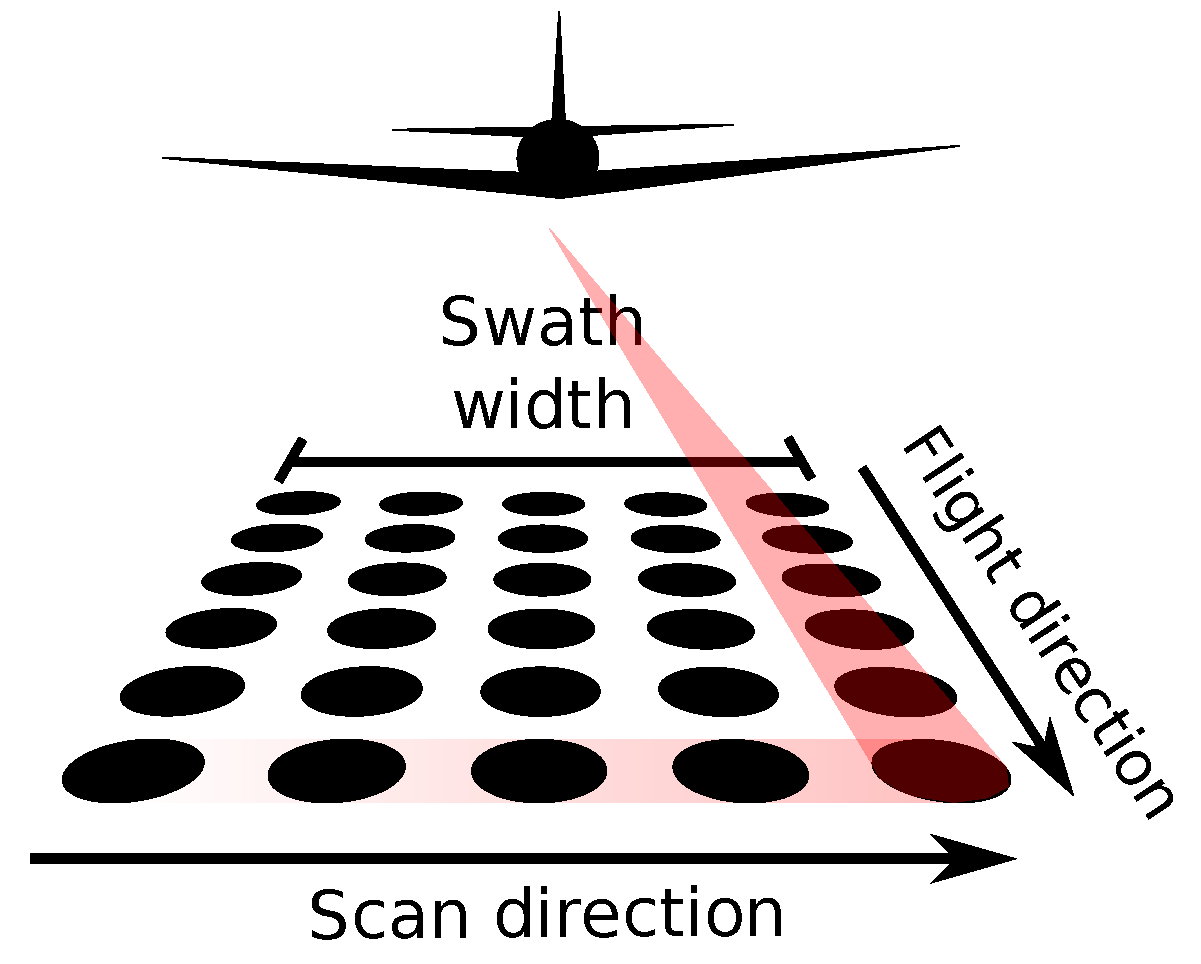

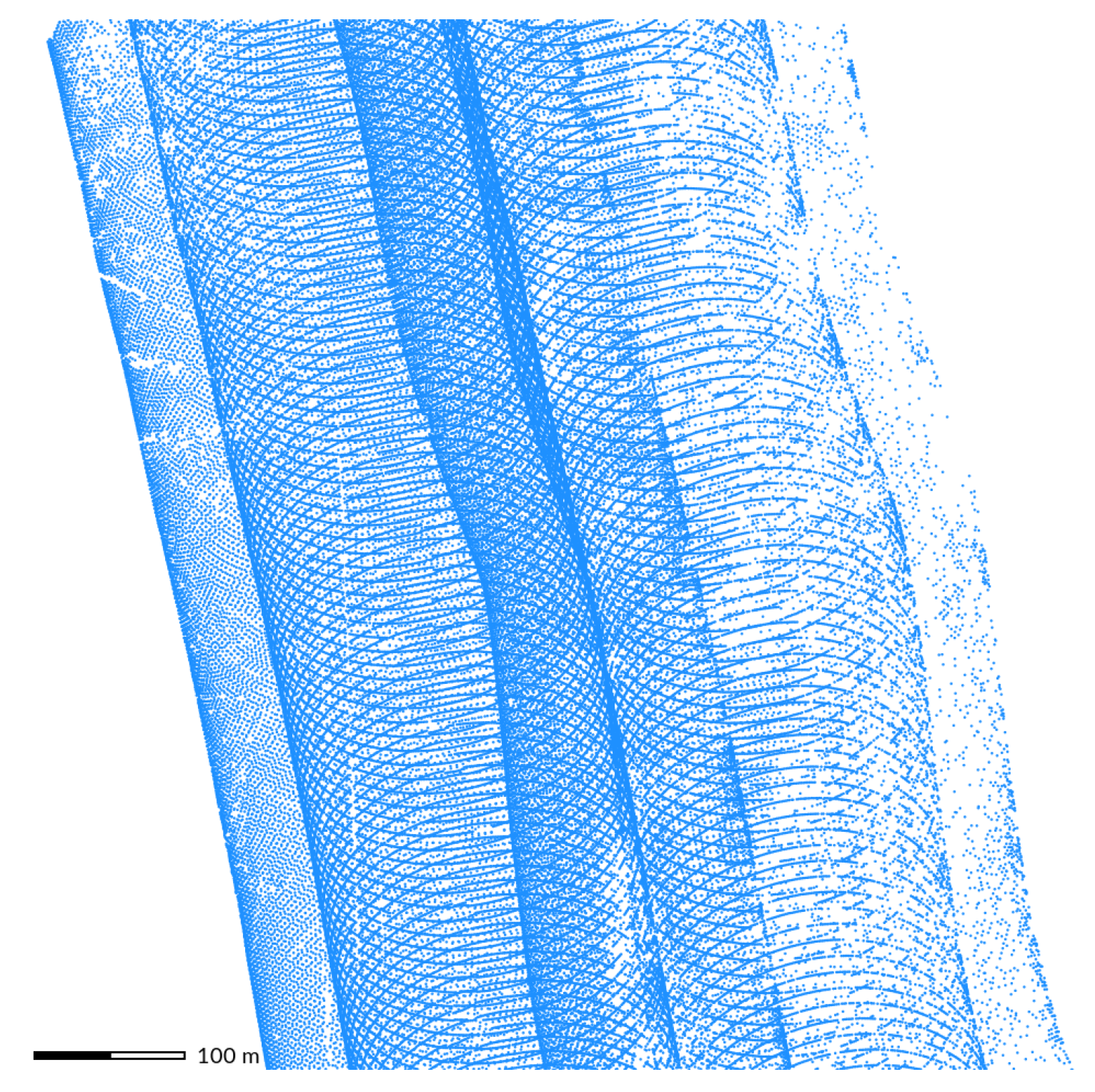



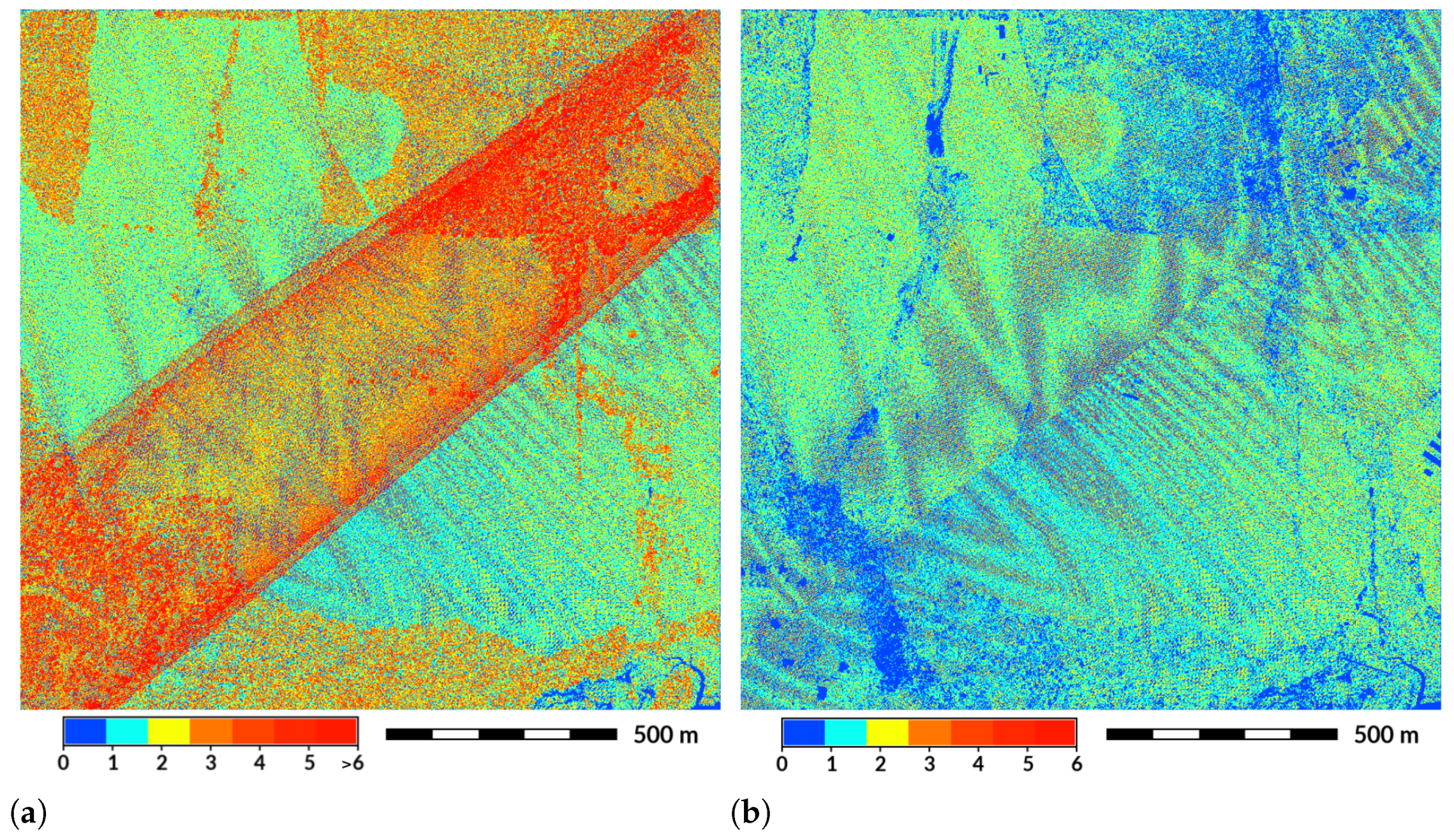


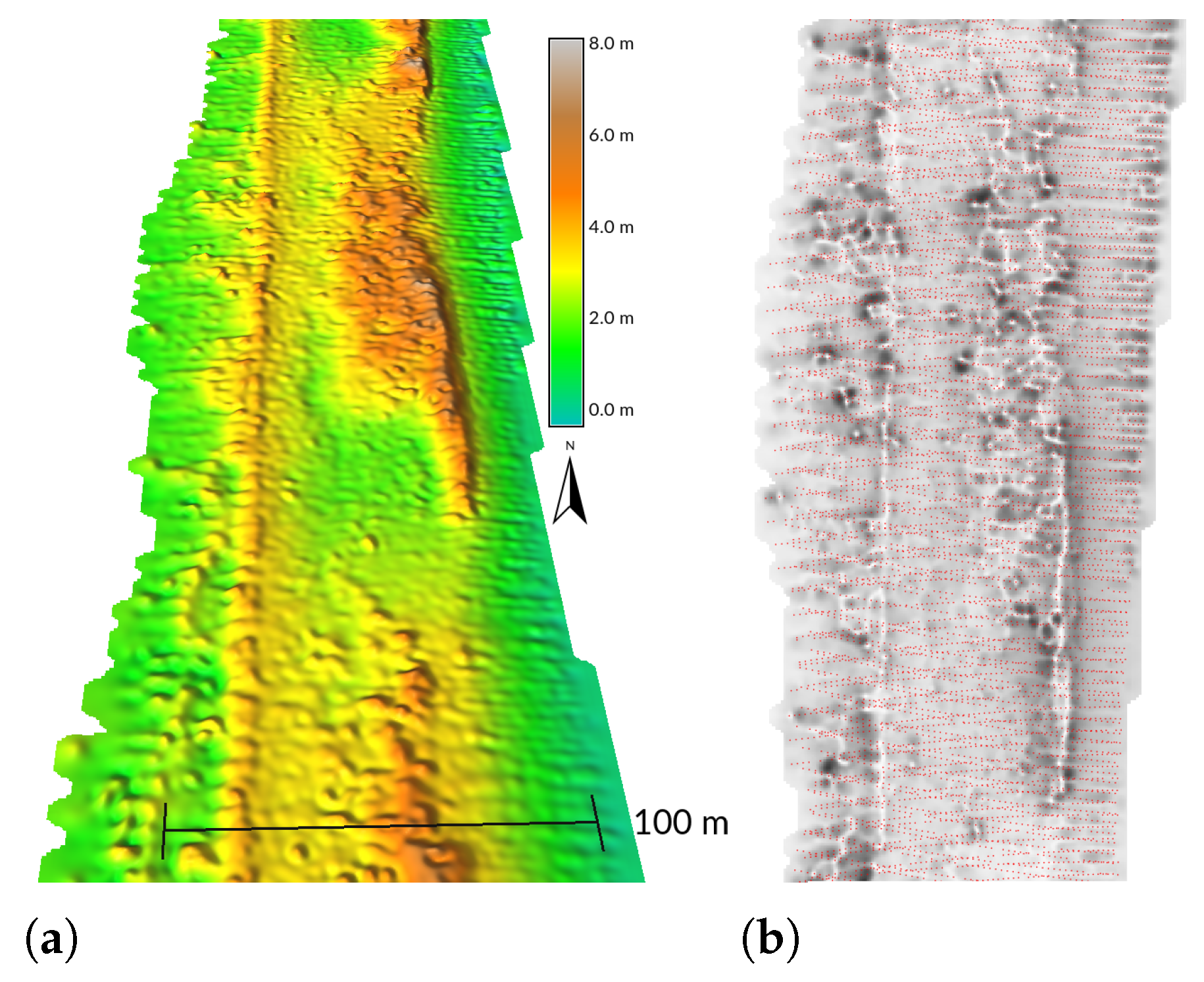

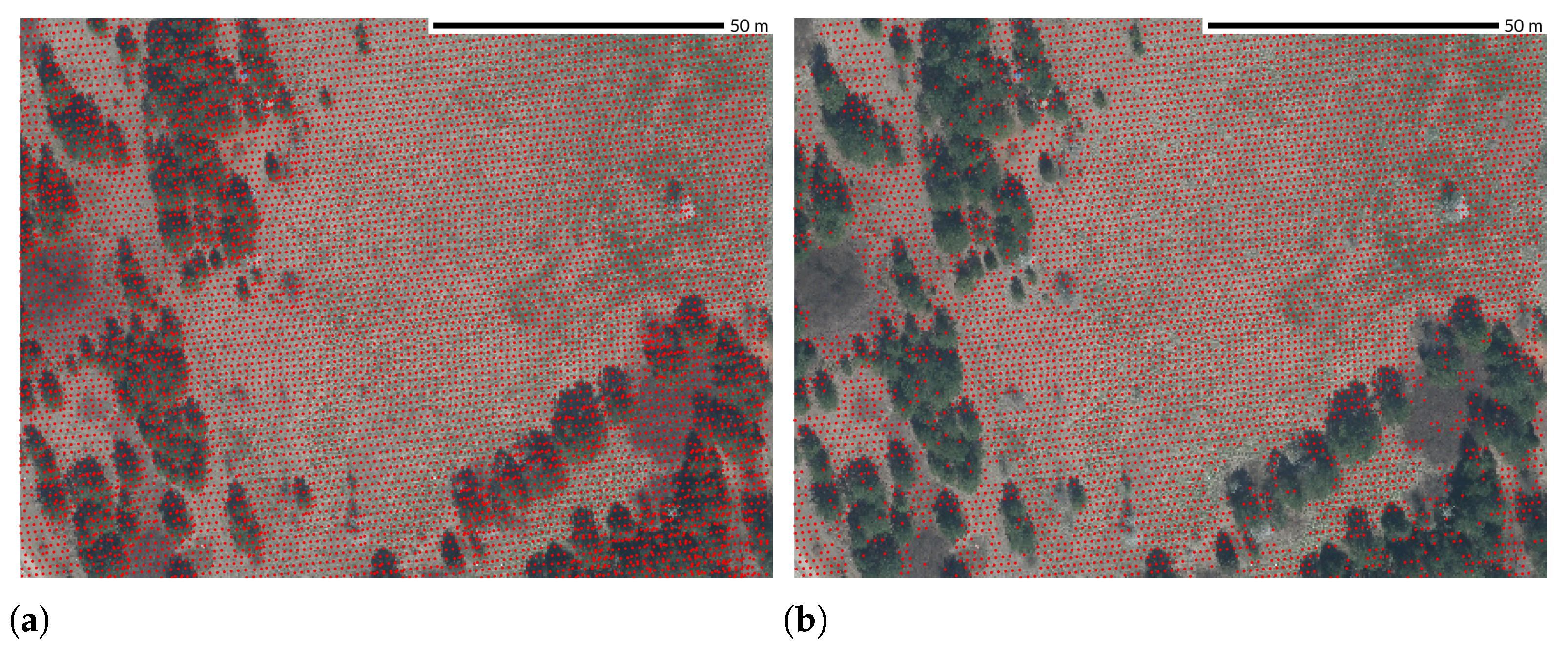

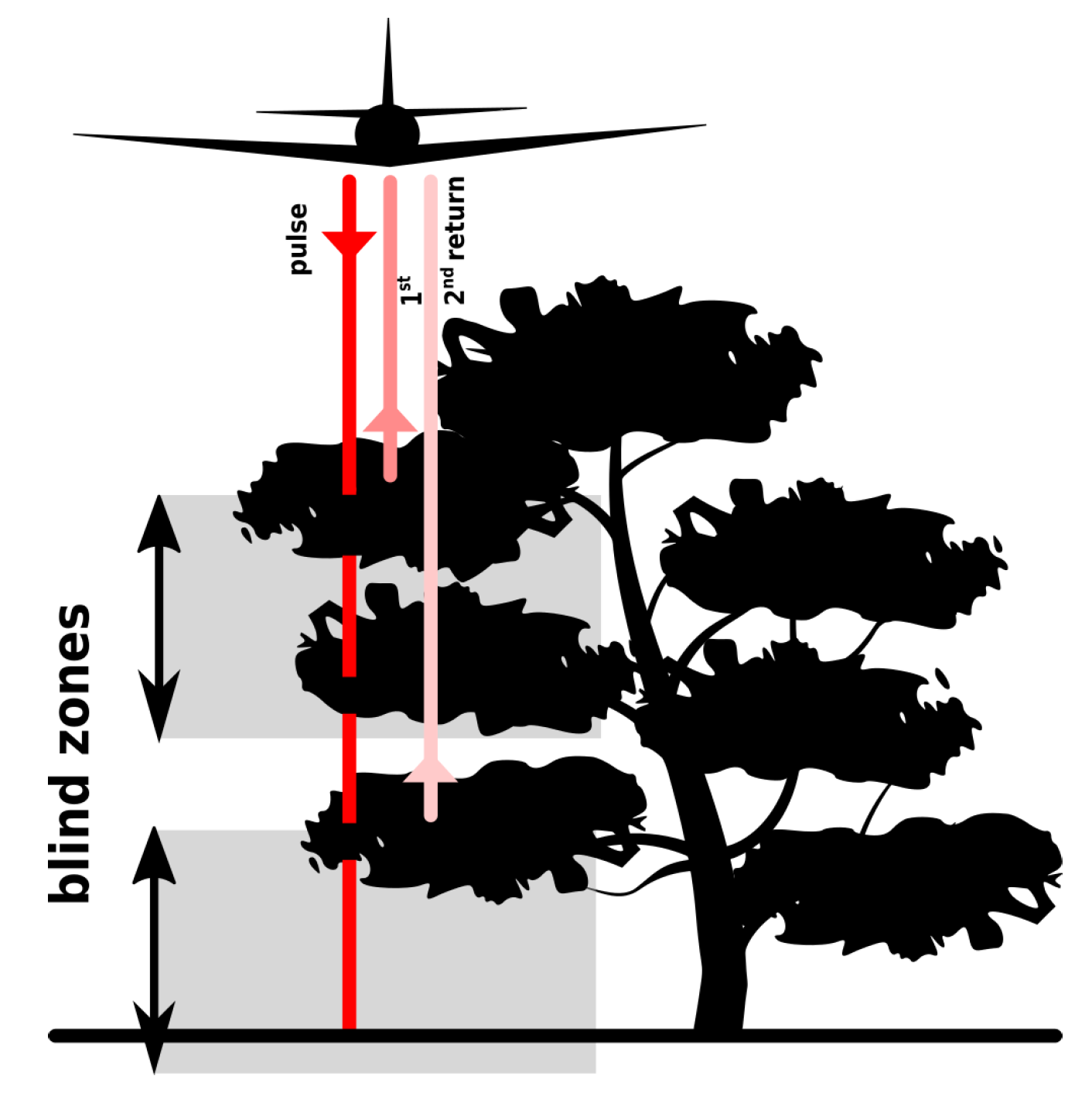
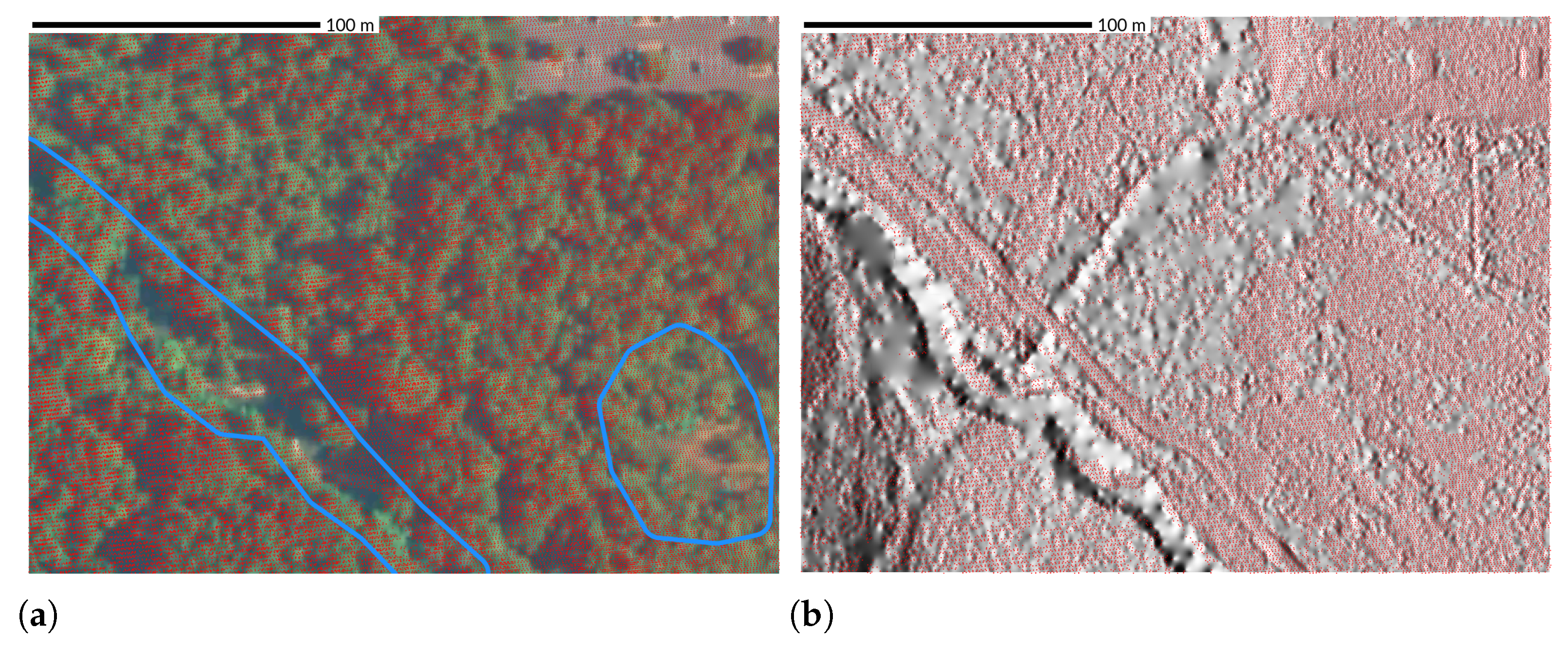
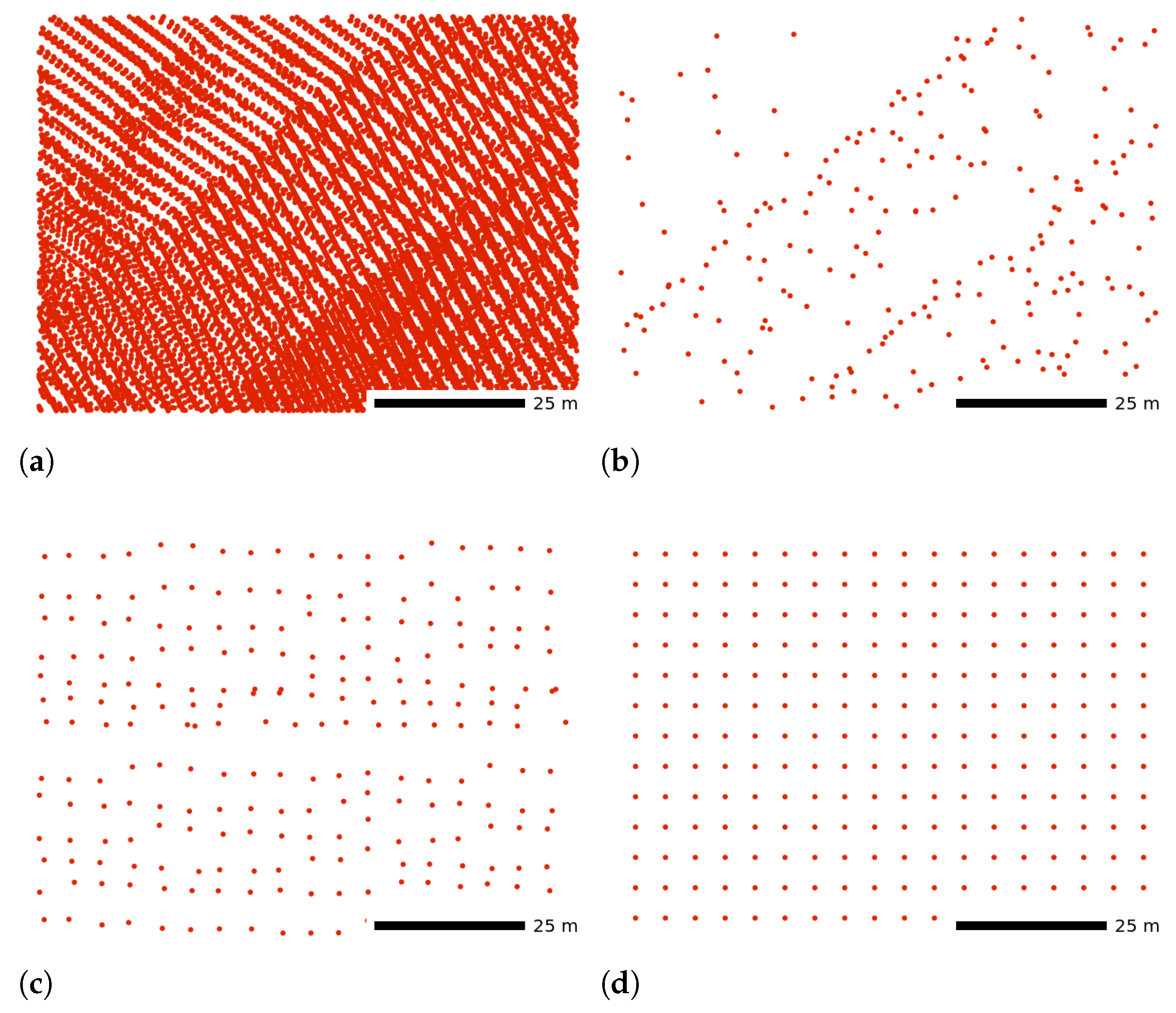
| Name | Year | Area | Collected by | Reference |
|---|---|---|---|---|
| NC Floodplain Mapping Program | 2015 | Selected counties in Piedmont | State of North Carolina | [42] |
| Wake County | 2013 | Wake County | Wake County government | [43] |
| NCALM | 2009 | Nantahala National Forest | NCALM | [44] |
| NOAA/NASA/USGS | 1999 | Coast of NC | NOAA, NASA, USGS | [45] |
| NASA/USGS | 2003 | Cape Hatteras | NASA, USGS | [46] |
| NOAA | 2008 | Coast of NC and Virginia | NOAA | [47] |
| Source of Density Variation | Possible Effect on Point Density |
|---|---|
| Scanner type | Change in overall pattern |
| Variable line scanner point spacing | Lower or higher density along the scan line |
| Variable speed or pitch | Stripes of higher and lower density in the flight direction (banding) |
| Variable altitude | Higher or lower overall density |
| Altitude change preventing swath overlap | Gaps without points |
| Roll change preventing swath overlap | Gaps without points |
| Missing or additional swath due to navigation error | Gaps without points or higher point density |
| Missing or additional swath due to error in flight planning | Gaps without points or higher point density |
| Cause of DEM Error | Possible Indication in Density or Pattern | Effect in DEM |
|---|---|---|
| Occlusion, low reflectivity | Gaps, very low density | Smooth areas (missing information) |
| Pitch changes and recording errors | Dense stripes | Elevation banding (waves) |
| Vertically unaligned swaths | Abrupt changes in pattern | Abrupt changes in elevation (break lines) |
| Vertically unaligned scan lines | Moiré effect, double scan lines | Corduroy effect (stripes) |
Disclaimer/Publisher’s Note: The statements, opinions and data contained in all publications are solely those of the individual author(s) and contributor(s) and not of MDPI and/or the editor(s). MDPI and/or the editor(s) disclaim responsibility for any injury to people or property resulting from any ideas, methods, instructions or products referred to in the content. |
© 2023 by the authors. Licensee MDPI, Basel, Switzerland. This article is an open access article distributed under the terms and conditions of the Creative Commons Attribution (CC BY) license (https://creativecommons.org/licenses/by/4.0/).
Share and Cite
Petras, V.; Petrasova, A.; McCarter, J.B.; Mitasova, H.; Meentemeyer, R.K. Point Density Variations in Airborne Lidar Point Clouds. Sensors 2023, 23, 1593. https://doi.org/10.3390/s23031593
Petras V, Petrasova A, McCarter JB, Mitasova H, Meentemeyer RK. Point Density Variations in Airborne Lidar Point Clouds. Sensors. 2023; 23(3):1593. https://doi.org/10.3390/s23031593
Chicago/Turabian StylePetras, Vaclav, Anna Petrasova, James B. McCarter, Helena Mitasova, and Ross K. Meentemeyer. 2023. "Point Density Variations in Airborne Lidar Point Clouds" Sensors 23, no. 3: 1593. https://doi.org/10.3390/s23031593
APA StylePetras, V., Petrasova, A., McCarter, J. B., Mitasova, H., & Meentemeyer, R. K. (2023). Point Density Variations in Airborne Lidar Point Clouds. Sensors, 23(3), 1593. https://doi.org/10.3390/s23031593









